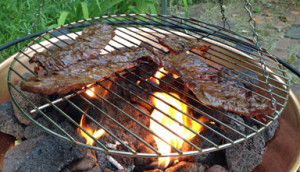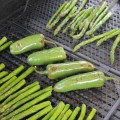 I’ve been cooking outdoors – grilling, barbecuing and even baking – for a long, long time but I remember when I first started and the mistakes I made including shattering a plate glass sliding door by having a hibachi too close to the door (that turned out to be a $500 steak). Outdoor cooking has a learning curve… it’s not that steep but it still takes time to convert your indoor culinary skills to the backyard. These are some “rookie” mistakes I made and how to avoid them.
I’ve been cooking outdoors – grilling, barbecuing and even baking – for a long, long time but I remember when I first started and the mistakes I made including shattering a plate glass sliding door by having a hibachi too close to the door (that turned out to be a $500 steak). Outdoor cooking has a learning curve… it’s not that steep but it still takes time to convert your indoor culinary skills to the backyard. These are some “rookie” mistakes I made and how to avoid them.
Grilling:
Having a Dirty Grill
Keep the grill grates clean. Scrub them before and after every cooking session. Believe me, dirty grates do not add “flavor” to your food. If the grates are really nasty use a steam cleaner and wire brush.
Having Poor Tools
Inexpensive tongs and spatulas are probably the worse culprits in most backyard arsenals. Visit a well-equipped cook shop or a restaurant supply depot and purchase long-handled spring-loaded tongs and a wide-blade spatula. They are relatively inexpensive and will last for a long time.
Using “One-Zone” Cooking
Set up the grill so there is a hot side and a cooler side that way you can move food from one to the other for even cooking. If cooking is only done on the hot side you’ll end up with meat that’s charred on the outside but still raw in the middle.
Stabbing Meat
Don’t use a fork to stab the meat. It lets the juice run out. Use tongs or a spatula to turn the meat. The meat is ready to be turned when it easily lifts off the grill grate.
Covering the Grill
You’re grilling, not smoking! Leave the cover off the grill while cooking.
Not Using a Thermometer
The only true way to tell if the meat is done is to use an instant-read thermometer… forget about the poke test. I use a Thermapen… it’s expensive but worth every penny.
Cooking at Too High a Temperature
The grill does not have to be thermonuclear to cook! Medium to medium-high temperatures are usually sufficient unless you want a quick sear on steak before moving it to the cooler side of the gill to finish cooking.
Grilling Too Early
Let the grill get up to temperature before beginning to cook. For a gas grill that usually means preheating on high for ten to 15 minutes and for a charcoal grill 30 to 40 minutes to achieve the desired temperature.
Running out of Fuel
Be sure you have enough fuel for the cook… don’t run out of propane; prepare another chimney of charcoal if you’re using briquettes. Nothing is worse than being halfway through cooking and running out of fuel!
Smoking:
Using Green Wood or the Wrong Wood
Unseasoned (green) wood doesn’t burn cleanly and gives an off flavor to food. You also don’t want to use any resinous wood such as pine for smoking. Use only seasoned hardwood – apple, maple, oak, hickory, etc. – for smoking.
Peeking Too Often
Every time you open the lid to look at what you’re cooking, the temperature will drop 20 to 30 degrees and that effects cooking time. Put the food in the smoker, monitor the temperature with a remote reading thermometer and let it cook.
Too Much Smoke
Smoke is good… too much smoke is bad. You want to have a “thin blue line” of smoke coming out of the cooker. Too much smoke makes for bitter tasting food.
Saucing Too Early
Don’t sauce the meat until the last 30 minutes of cooking otherwise the sugars in the sauce caramelize and make a thick layer hiding the flavor of the meat.
Believing the Hood Thermometer
Never believe the hood thermometer. It’s a few inches above the cooking grate and they are usually very inaccurate. If you want to monitor the grate temperature invest in a remote-reading thermometer.
Rushing the Cook
It’s said barbecue is done when it’s done… that’s a good adage. While general recommendations are usually pretty spot-on, it’s done when it’s done. Some chicken may take 20 minutes per pound and others 30… you never really know until you’re cooking. Give yourself plenty of time for a great barbecue. And build in a rest time… most meats should rest at least 10 minutes before slicing to allow the juices to redistribute.
Not Controlling Temperature
Don’t let the smoker get away from you… you want to control the temperature between 225 and 275 degrees F. by adjusting the vents. Try to get the smoker stabilized before beginning the cooking session and keep it that way by adjusting the vents (the top vent controls the smoke and the bottom vent regulates the heat) and adding more fuel as needed.
Latest posts by Mike Stines (see all)
- Winter Shrimp Festival: Comfort of the Sea - 11/11/2022
- Singapore Fried Prawns with Dried Chile - 10/31/2022
- Planked Trout with Cayenne and Herbs - 08/02/2022









